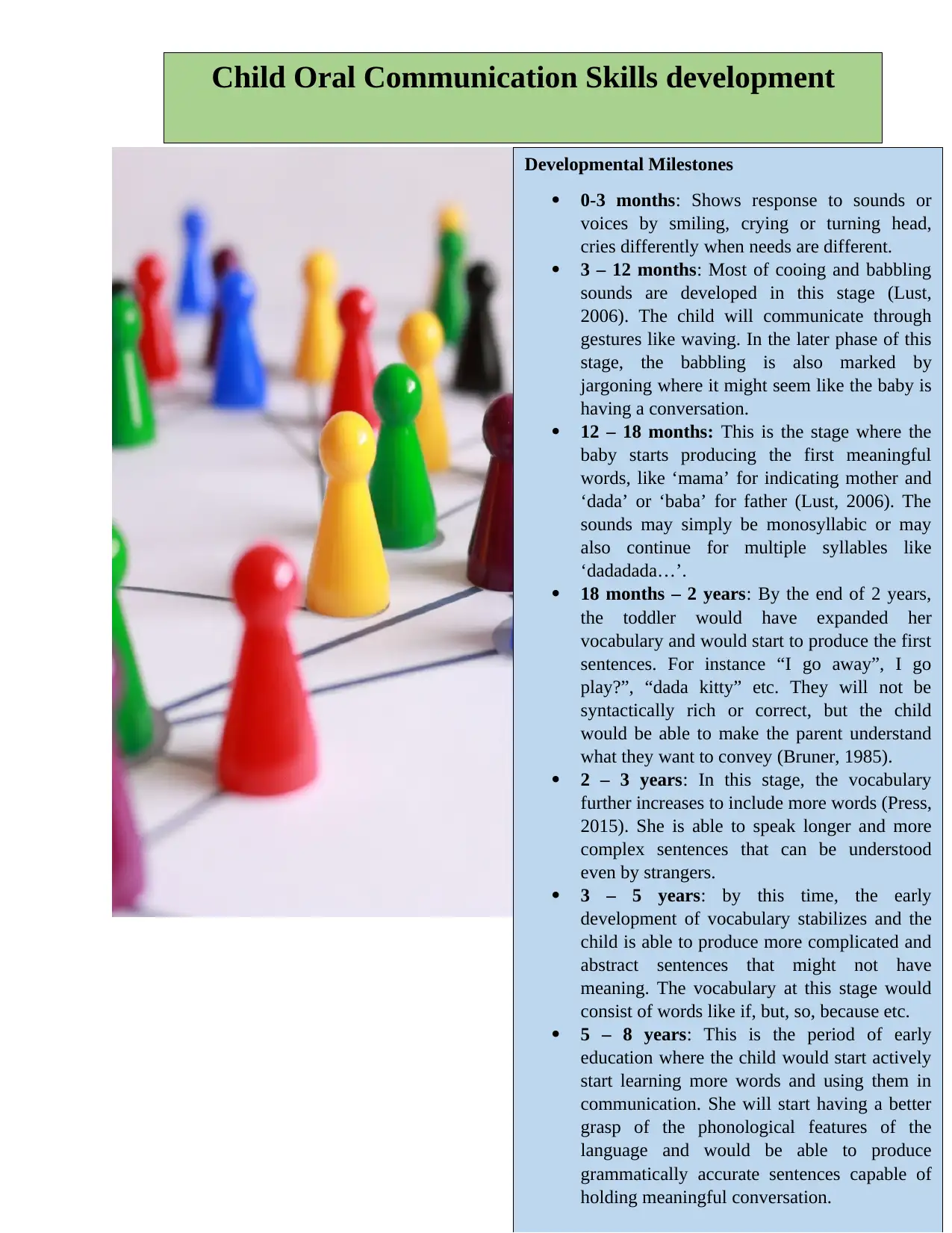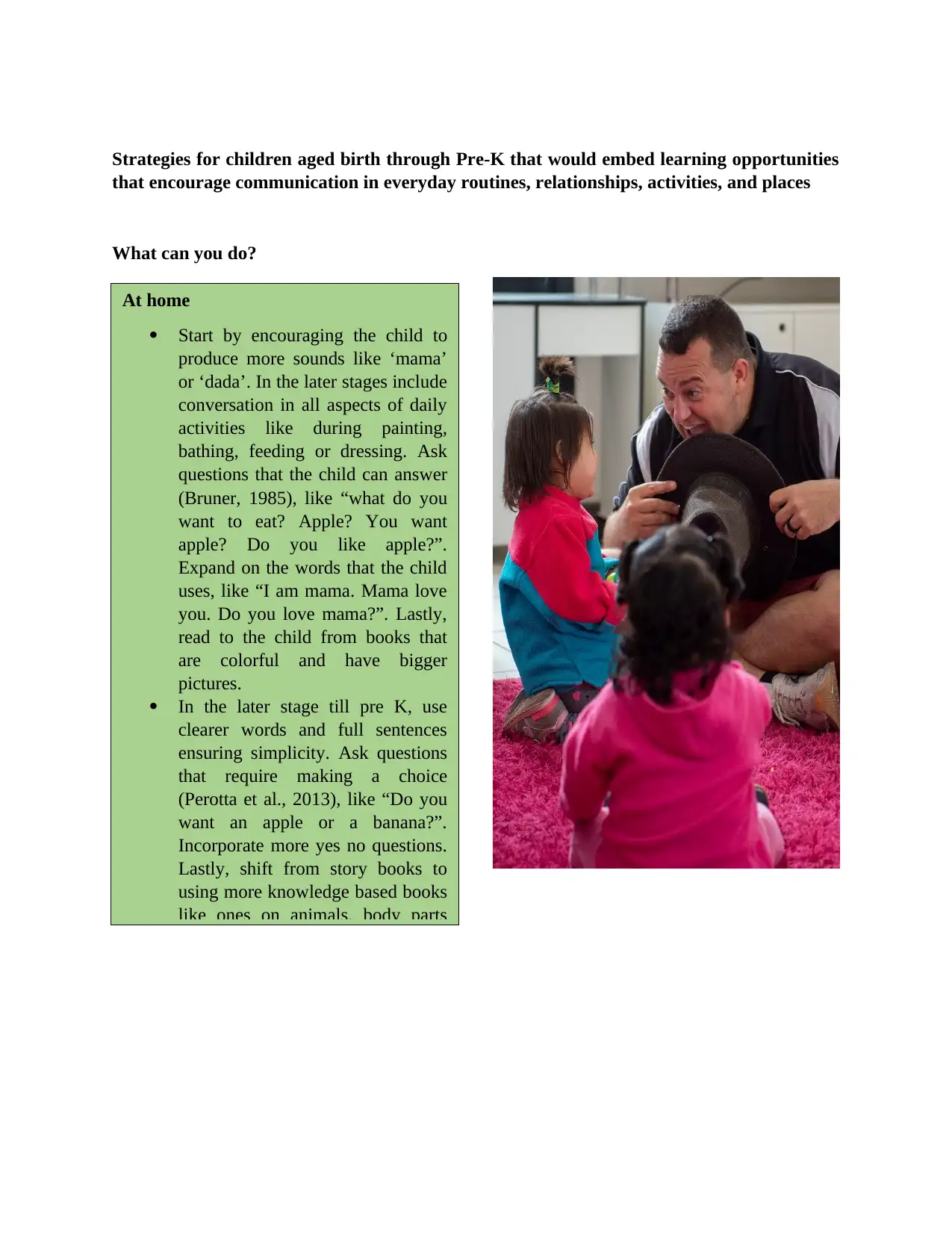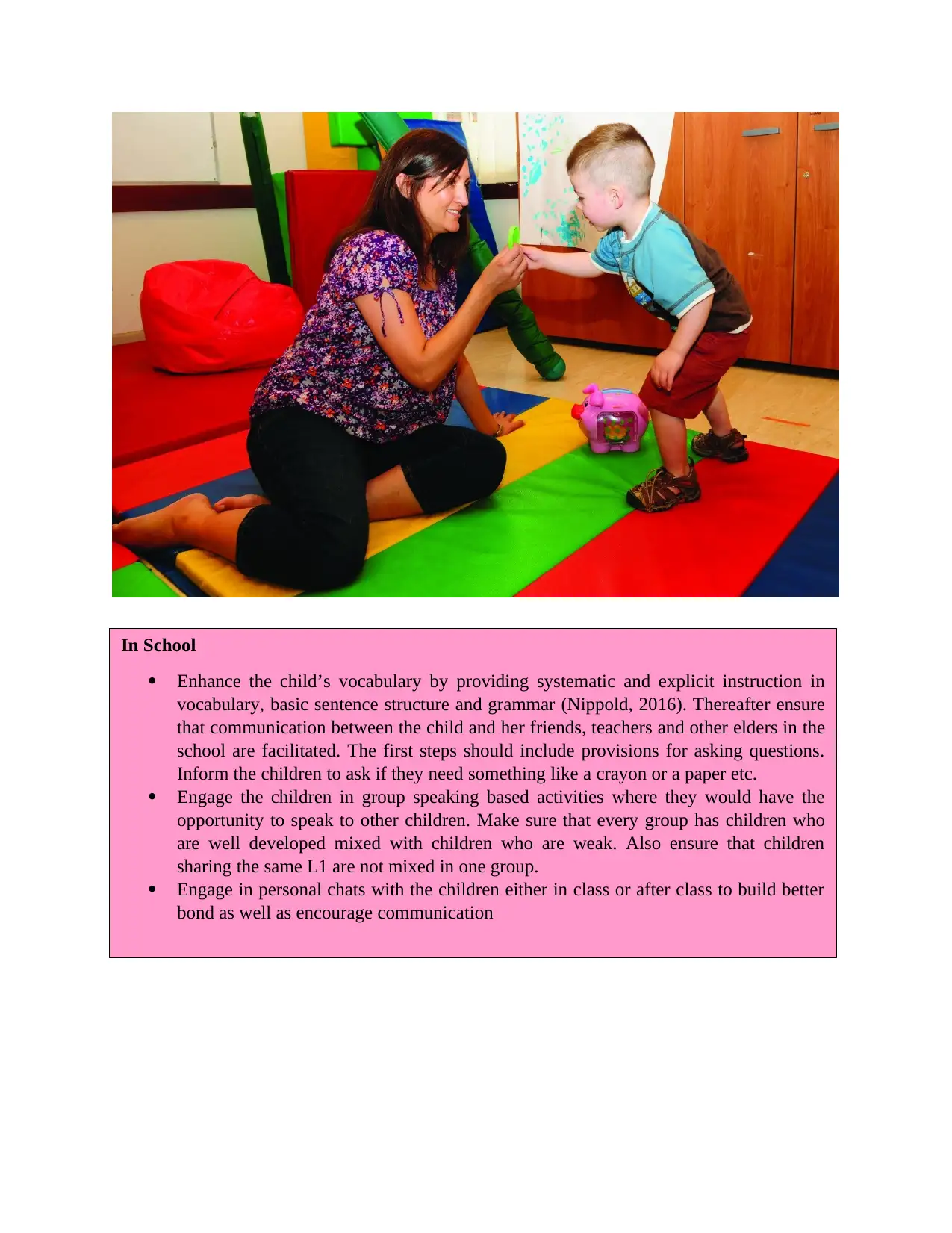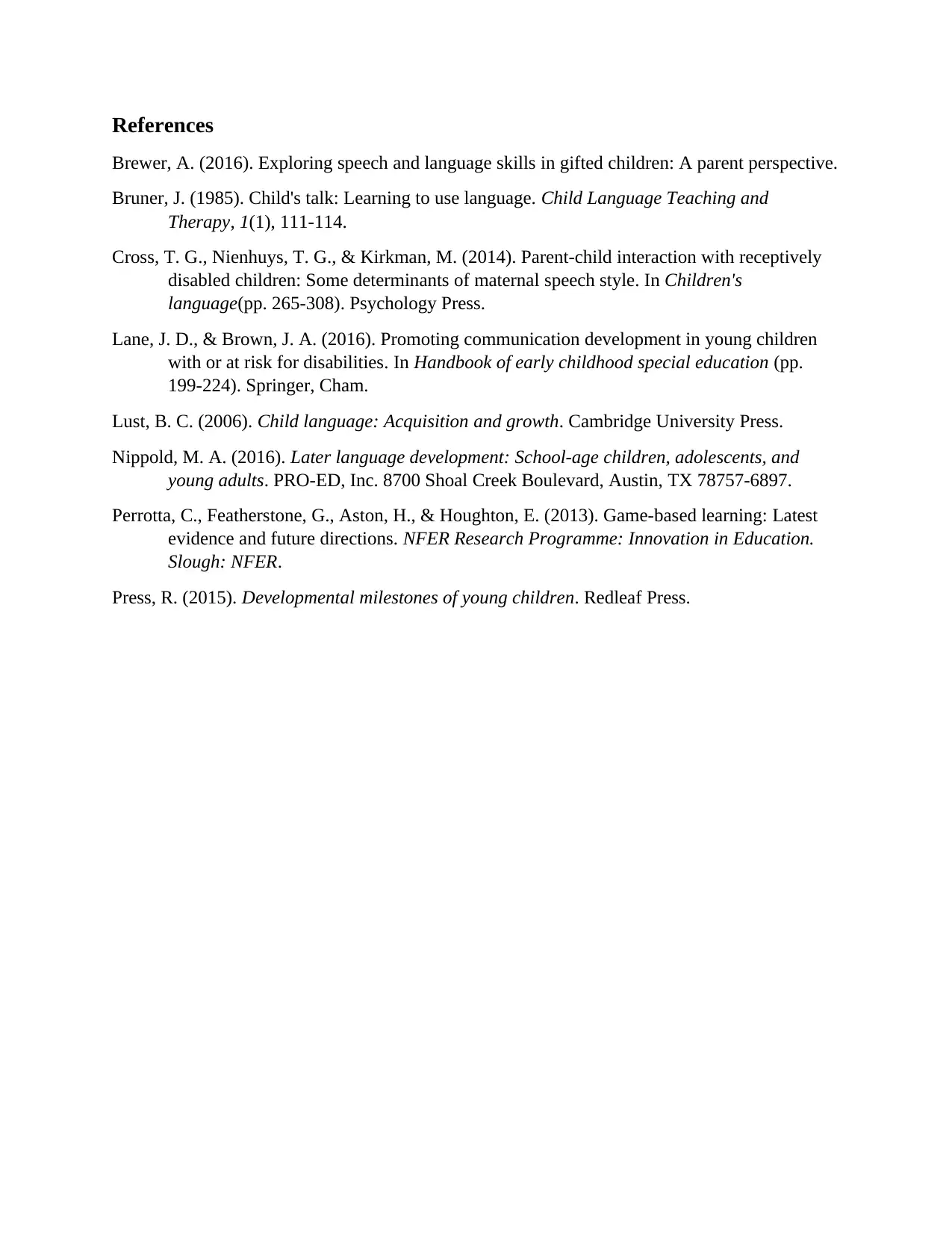Child Oral Communication Skills Development: Strategies and Milestones
VerifiedAdded on 2022/11/18
|7
|2589
|236
AI Summary
This brochure provides information on the developmental milestones of oral communication skills in children and strategies to enhance them at home and in school. It also includes resources for children with disabilities and gifted children. The information is based on extensive research into child language acquisition and speech development.
Contribute Materials
Your contribution can guide someone’s learning journey. Share your
documents today.

DEVELOPMENTAL MILESTONES
Name of the Student
Name of the University
Author note
Name of the Student
Name of the University
Author note
Secure Best Marks with AI Grader
Need help grading? Try our AI Grader for instant feedback on your assignments.

Child Oral Communication Skills development
Developmental Milestones
0-3 months: Shows response to sounds or
voices by smiling, crying or turning head,
cries differently when needs are different.
3 – 12 months: Most of cooing and babbling
sounds are developed in this stage (Lust,
2006). The child will communicate through
gestures like waving. In the later phase of this
stage, the babbling is also marked by
jargoning where it might seem like the baby is
having a conversation.
12 – 18 months: This is the stage where the
baby starts producing the first meaningful
words, like ‘mama’ for indicating mother and
‘dada’ or ‘baba’ for father (Lust, 2006). The
sounds may simply be monosyllabic or may
also continue for multiple syllables like
‘dadadada…’.
18 months – 2 years: By the end of 2 years,
the toddler would have expanded her
vocabulary and would start to produce the first
sentences. For instance “I go away”, I go
play?”, “dada kitty” etc. They will not be
syntactically rich or correct, but the child
would be able to make the parent understand
what they want to convey (Bruner, 1985).
2 – 3 years: In this stage, the vocabulary
further increases to include more words (Press,
2015). She is able to speak longer and more
complex sentences that can be understood
even by strangers.
3 – 5 years: by this time, the early
development of vocabulary stabilizes and the
child is able to produce more complicated and
abstract sentences that might not have
meaning. The vocabulary at this stage would
consist of words like if, but, so, because etc.
5 – 8 years: This is the period of early
education where the child would start actively
start learning more words and using them in
communication. She will start having a better
grasp of the phonological features of the
language and would be able to produce
grammatically accurate sentences capable of
holding meaningful conversation.
Developmental Milestones
0-3 months: Shows response to sounds or
voices by smiling, crying or turning head,
cries differently when needs are different.
3 – 12 months: Most of cooing and babbling
sounds are developed in this stage (Lust,
2006). The child will communicate through
gestures like waving. In the later phase of this
stage, the babbling is also marked by
jargoning where it might seem like the baby is
having a conversation.
12 – 18 months: This is the stage where the
baby starts producing the first meaningful
words, like ‘mama’ for indicating mother and
‘dada’ or ‘baba’ for father (Lust, 2006). The
sounds may simply be monosyllabic or may
also continue for multiple syllables like
‘dadadada…’.
18 months – 2 years: By the end of 2 years,
the toddler would have expanded her
vocabulary and would start to produce the first
sentences. For instance “I go away”, I go
play?”, “dada kitty” etc. They will not be
syntactically rich or correct, but the child
would be able to make the parent understand
what they want to convey (Bruner, 1985).
2 – 3 years: In this stage, the vocabulary
further increases to include more words (Press,
2015). She is able to speak longer and more
complex sentences that can be understood
even by strangers.
3 – 5 years: by this time, the early
development of vocabulary stabilizes and the
child is able to produce more complicated and
abstract sentences that might not have
meaning. The vocabulary at this stage would
consist of words like if, but, so, because etc.
5 – 8 years: This is the period of early
education where the child would start actively
start learning more words and using them in
communication. She will start having a better
grasp of the phonological features of the
language and would be able to produce
grammatically accurate sentences capable of
holding meaningful conversation.

Strategies for children aged birth through Pre-K that would embed learning opportunities
that encourage communication in everyday routines, relationships, activities, and places
What can you do?
At home
Start by encouraging the child to
produce more sounds like ‘mama’
or ‘dada’. In the later stages include
conversation in all aspects of daily
activities like during painting,
bathing, feeding or dressing. Ask
questions that the child can answer
(Bruner, 1985), like “what do you
want to eat? Apple? You want
apple? Do you like apple?”.
Expand on the words that the child
uses, like “I am mama. Mama love
you. Do you love mama?”. Lastly,
read to the child from books that
are colorful and have bigger
pictures.
In the later stage till pre K, use
clearer words and full sentences
ensuring simplicity. Ask questions
that require making a choice
(Perotta et al., 2013), like “Do you
want an apple or a banana?”.
Incorporate more yes no questions.
Lastly, shift from story books to
using more knowledge based books
like ones on animals, body parts
that encourage communication in everyday routines, relationships, activities, and places
What can you do?
At home
Start by encouraging the child to
produce more sounds like ‘mama’
or ‘dada’. In the later stages include
conversation in all aspects of daily
activities like during painting,
bathing, feeding or dressing. Ask
questions that the child can answer
(Bruner, 1985), like “what do you
want to eat? Apple? You want
apple? Do you like apple?”.
Expand on the words that the child
uses, like “I am mama. Mama love
you. Do you love mama?”. Lastly,
read to the child from books that
are colorful and have bigger
pictures.
In the later stage till pre K, use
clearer words and full sentences
ensuring simplicity. Ask questions
that require making a choice
(Perotta et al., 2013), like “Do you
want an apple or a banana?”.
Incorporate more yes no questions.
Lastly, shift from story books to
using more knowledge based books
like ones on animals, body parts

In School
Enhance the child’s vocabulary by providing systematic and explicit instruction in
vocabulary, basic sentence structure and grammar (Nippold, 2016). Thereafter ensure
that communication between the child and her friends, teachers and other elders in the
school are facilitated. The first steps should include provisions for asking questions.
Inform the children to ask if they need something like a crayon or a paper etc.
Engage the children in group speaking based activities where they would have the
opportunity to speak to other children. Make sure that every group has children who
are well developed mixed with children who are weak. Also ensure that children
sharing the same L1 are not mixed in one group.
Engage in personal chats with the children either in class or after class to build better
bond as well as encourage communication
Enhance the child’s vocabulary by providing systematic and explicit instruction in
vocabulary, basic sentence structure and grammar (Nippold, 2016). Thereafter ensure
that communication between the child and her friends, teachers and other elders in the
school are facilitated. The first steps should include provisions for asking questions.
Inform the children to ask if they need something like a crayon or a paper etc.
Engage the children in group speaking based activities where they would have the
opportunity to speak to other children. Make sure that every group has children who
are well developed mixed with children who are weak. Also ensure that children
sharing the same L1 are not mixed in one group.
Engage in personal chats with the children either in class or after class to build better
bond as well as encourage communication
Secure Best Marks with AI Grader
Need help grading? Try our AI Grader for instant feedback on your assignments.

For Children with disabilities (Lane & Brown, 2016)
While in school, the first step should be to identify the specific disability that the child
has. Make sure to engage the children in socially inclusive games and activities ensuring
that the child does not face discrimination from others. Be a part of the group yourself.
Actively engage the group in activities that promote inter member communication.
Individually, engage with the child in argumentative communication, asking questions
and providing responses.
In home, ensure that the child has ample opportunity to express herself in whatever way
she seems fit. Do not discriminate between the manners of communication between a
disabled child and a child with no disabilities. Make sure to ask repeated questions
about feelings and what the child needs. Let them speak and interact freely as they feel
comfortable. Use maternal speech for comforting (Cross, Nienhuys & Kirkman, 2014)
For gifted children (Brewer, 2016)
One effective strategy to develop
communicative skills in gifted
students in schools is to arrange a
conversational activity by putting
the children in power pairs where
two different students from two
poles of academic and cognitive
development are teamed together to
communicate and exchange ideas.
Ensure that in a home setting, the
child communicates with everyone
she comes in contact with.
Involving the children in casual
family discussions is a good way of
promoting oral skills development.
Two services that you can refer to
Play schools, kindergartens and daycare services.
Speech therapists.
While in school, the first step should be to identify the specific disability that the child
has. Make sure to engage the children in socially inclusive games and activities ensuring
that the child does not face discrimination from others. Be a part of the group yourself.
Actively engage the group in activities that promote inter member communication.
Individually, engage with the child in argumentative communication, asking questions
and providing responses.
In home, ensure that the child has ample opportunity to express herself in whatever way
she seems fit. Do not discriminate between the manners of communication between a
disabled child and a child with no disabilities. Make sure to ask repeated questions
about feelings and what the child needs. Let them speak and interact freely as they feel
comfortable. Use maternal speech for comforting (Cross, Nienhuys & Kirkman, 2014)
For gifted children (Brewer, 2016)
One effective strategy to develop
communicative skills in gifted
students in schools is to arrange a
conversational activity by putting
the children in power pairs where
two different students from two
poles of academic and cognitive
development are teamed together to
communicate and exchange ideas.
Ensure that in a home setting, the
child communicates with everyone
she comes in contact with.
Involving the children in casual
family discussions is a good way of
promoting oral skills development.
Two services that you can refer to
Play schools, kindergartens and daycare services.
Speech therapists.

Reflection
For both parents as well as teachers, it is important to have a thorough knowledge of the
developmental milestones when it comes to development of oral communication skills in
children. First of all, it helps differentiate between what the child needs and what the child
expresses. The early stage of life is significantly marked by the development of primary
communicative features. Research suggests that the early developmental features of
communication are significantly marked by a child’s ability to produce sounds to indicate their
needs, satisfaction, distress etc. In my opinion, having a knowledge of what the child is trying to
say not only makes parenting easier, but also helps the child throughout her process of
development. Starting from the early stage of life where crying does not always indicate sadness
but also the need for something, gradually progressing towards the stages of cooing and
babbling, followed by the production of first words and so on, the development of
communication in children is a progressive event. They also help to develop new and interesting
ways to engage the children in communication through which they can help develop the oral
communication skills of the children.
The information that is provided above is not random but has been gathered after
studying certain key academic resources. These information are a product of extensive research
into child language acquisition and speech development. They highlight information about the
stages in speech development as well as what can be done to enhance speech production and
development both at home and in school, for all kinds of children. I believe that the brochure can
serve as a viable resource material for both parents and general education teachers.
For both parents as well as teachers, it is important to have a thorough knowledge of the
developmental milestones when it comes to development of oral communication skills in
children. First of all, it helps differentiate between what the child needs and what the child
expresses. The early stage of life is significantly marked by the development of primary
communicative features. Research suggests that the early developmental features of
communication are significantly marked by a child’s ability to produce sounds to indicate their
needs, satisfaction, distress etc. In my opinion, having a knowledge of what the child is trying to
say not only makes parenting easier, but also helps the child throughout her process of
development. Starting from the early stage of life where crying does not always indicate sadness
but also the need for something, gradually progressing towards the stages of cooing and
babbling, followed by the production of first words and so on, the development of
communication in children is a progressive event. They also help to develop new and interesting
ways to engage the children in communication through which they can help develop the oral
communication skills of the children.
The information that is provided above is not random but has been gathered after
studying certain key academic resources. These information are a product of extensive research
into child language acquisition and speech development. They highlight information about the
stages in speech development as well as what can be done to enhance speech production and
development both at home and in school, for all kinds of children. I believe that the brochure can
serve as a viable resource material for both parents and general education teachers.

References
Brewer, A. (2016). Exploring speech and language skills in gifted children: A parent perspective.
Bruner, J. (1985). Child's talk: Learning to use language. Child Language Teaching and
Therapy, 1(1), 111-114.
Cross, T. G., Nienhuys, T. G., & Kirkman, M. (2014). Parent-child interaction with receptively
disabled children: Some determinants of maternal speech style. In Children's
language(pp. 265-308). Psychology Press.
Lane, J. D., & Brown, J. A. (2016). Promoting communication development in young children
with or at risk for disabilities. In Handbook of early childhood special education (pp.
199-224). Springer, Cham.
Lust, B. C. (2006). Child language: Acquisition and growth. Cambridge University Press.
Nippold, M. A. (2016). Later language development: School-age children, adolescents, and
young adults. PRO-ED, Inc. 8700 Shoal Creek Boulevard, Austin, TX 78757-6897.
Perrotta, C., Featherstone, G., Aston, H., & Houghton, E. (2013). Game-based learning: Latest
evidence and future directions. NFER Research Programme: Innovation in Education.
Slough: NFER.
Press, R. (2015). Developmental milestones of young children. Redleaf Press.
Brewer, A. (2016). Exploring speech and language skills in gifted children: A parent perspective.
Bruner, J. (1985). Child's talk: Learning to use language. Child Language Teaching and
Therapy, 1(1), 111-114.
Cross, T. G., Nienhuys, T. G., & Kirkman, M. (2014). Parent-child interaction with receptively
disabled children: Some determinants of maternal speech style. In Children's
language(pp. 265-308). Psychology Press.
Lane, J. D., & Brown, J. A. (2016). Promoting communication development in young children
with or at risk for disabilities. In Handbook of early childhood special education (pp.
199-224). Springer, Cham.
Lust, B. C. (2006). Child language: Acquisition and growth. Cambridge University Press.
Nippold, M. A. (2016). Later language development: School-age children, adolescents, and
young adults. PRO-ED, Inc. 8700 Shoal Creek Boulevard, Austin, TX 78757-6897.
Perrotta, C., Featherstone, G., Aston, H., & Houghton, E. (2013). Game-based learning: Latest
evidence and future directions. NFER Research Programme: Innovation in Education.
Slough: NFER.
Press, R. (2015). Developmental milestones of young children. Redleaf Press.
1 out of 7
Your All-in-One AI-Powered Toolkit for Academic Success.
+13062052269
info@desklib.com
Available 24*7 on WhatsApp / Email
![[object Object]](/_next/static/media/star-bottom.7253800d.svg)
Unlock your academic potential
© 2024 | Zucol Services PVT LTD | All rights reserved.